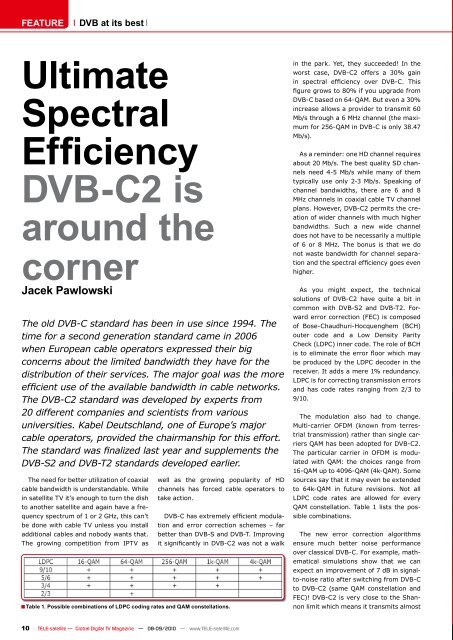Ultra HD - TELE-satellite International Magazine
Ultra HD - TELE-satellite International Magazine
Ultra HD - TELE-satellite International Magazine
You also want an ePaper? Increase the reach of your titles
YUMPU automatically turns print PDFs into web optimized ePapers that Google loves.
FEATURE<br />
■<br />
DVB at its best<br />
Ultimate<br />
Spectral<br />
Efficiency<br />
DVB-C2 is<br />
around the<br />
corner<br />
Jacek Pawlowski<br />
The old DVB-C standard has been in use since 1994. The<br />
time for a second generation standard came in 2006<br />
when European cable operators expressed their big<br />
concerns about the limited bandwidth they have for the<br />
distribution of their services. The major goal was the more<br />
efficient use of the available bandwidth in cable networks.<br />
The DVB-C2 standard was developed by experts from<br />
20 different companies and scientists from various<br />
universities. Kabel Deutschland, one of Europe’s major<br />
cable operators, provided the chairmanship for this effort.<br />
The standard was finalized last year and supplements the<br />
DVB-S2 and DVB-T2 standards developed earlier.<br />
The need for better utilization of coaxial<br />
cable bandwidth is understandable. While<br />
in <strong>satellite</strong> TV it’s enough to turn the dish<br />
to another <strong>satellite</strong> and again have a frequency<br />
spectrum of 1 or 2 GHz, this can’t<br />
be done with cable TV unless you install<br />
additional cables and nobody wants that.<br />
The growing competition from IPTV as<br />
well as the growing popularity of <strong>HD</strong><br />
channels has forced cable operators to<br />
take action.<br />
DVB-C has extremely efficient modulation<br />
and error correction schemes – far<br />
better than DVB-S and DVB-T. Improving<br />
it significantly in DVB-C2 was not a walk<br />
Table 1. Possible combinations of LDPC coding rates and QAM constellations.<br />
10 <strong>TELE</strong>-<strong>satellite</strong> — Global Digital TV <strong>Magazine</strong> — 08-09/2010 — www.<strong>TELE</strong>-<strong>satellite</strong>.com<br />
in the park. Yet, they succeeded! In the<br />
worst case, DVB-C2 offers a 30% gain<br />
in spectral efficiency over DVB-C. This<br />
figure grows to 80% if you upgrade from<br />
DVB-C based on 64-QAM. But even a 30%<br />
increase allows a provider to transmit 60<br />
Mb/s through a 6 MHz channel (the maximum<br />
for 256-QAM in DVB-C is only 38.47<br />
Mb/s).<br />
As a reminder: one <strong>HD</strong> channel requires<br />
about 20 Mb/s. The best quality SD channels<br />
need 4-5 Mb/s while many of them<br />
typically use only 2-3 Mb/s. Speaking of<br />
channel bandwidths, there are 6 and 8<br />
MHz channels in coaxial cable TV channel<br />
plans. However, DVB-C2 permits the creation<br />
of wider channels with much higher<br />
bandwidths. Such a new wide channel<br />
does not have to be necessarily a multiple<br />
of 6 or 8 MHz. The bonus is that we do<br />
not waste bandwidth for channel separation<br />
and the spectral efficiency goes even<br />
higher.<br />
As you might expect, the technical<br />
solutions of DVB-C2 have quite a bit in<br />
common with DVB-S2 and DVB-T2. Forward<br />
error correction (FEC) is composed<br />
of Bose-Chaudhuri-Hocquenghem (BCH)<br />
outer code and a Low Density Parity<br />
Check (LDPC) inner code. The role of BCH<br />
is to eliminate the error floor which may<br />
be produced by the LDPC decoder in the<br />
receiver. It adds a mere 1% redundancy.<br />
LDPC is for correcting transmission errors<br />
and has code rates ranging from 2/3 to<br />
9/10.<br />
The modulation also had to change.<br />
Multi-carrier OFDM (known from terrestrial<br />
transmission) rather than single carriers<br />
QAM has been adopted for DVB-C2.<br />
The particular carrier in OFDM is modulated<br />
with QAM: the choices range from<br />
16-QAM up to 4096-QAM (4k-QAM). Some<br />
sources say that it may even be extended<br />
to 64k-QAM in future revisions. Not all<br />
LDPC code rates are allowed for every<br />
QAM constellation. Table 1 lists the possible<br />
combinations.<br />
The new error correction algorithms<br />
ensure much better noise performance<br />
over classical DVB-C. For example, mathematical<br />
simulations show that we can<br />
expect an improvement of 7 dB in signalto-noise<br />
ratio after switching from DVB-C<br />
to DVB-C2 (same QAM constellation and<br />
FEC)! DVB-C2 is very close to the Shannon<br />
limit which means it transmits almost

















